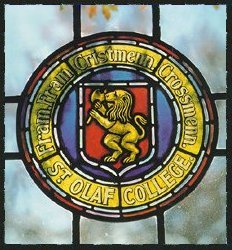| |
-----------------------
Program
|
Sept 19,
1978 |
|
|
Sept 20,
1978 |
-
Breakfast at
Hotel
-
Morning Free
-
Orientation
Meeting at Hotel
-
Lecture:
"Main Aspects of Ancient Egyptian Civilization and Political History", Dr.
Zaki Iskander, Former Director of Antiquities Dept
|
|
Sept 21,
1978 |
|
|
Sept 22,
1978 |
-
Breakfast at
Hotel
-
Lecture:
"Islam", Dr. Arnold Green, Associate Professor of History
-
Sailing on a
felucca boat on the Nile
|
|
Sept 23,
1978 |
-
Breakfast at
Hotel
-
Lecture:
"The Rise of Modern Egypt in the Nineteenth Century", Dr. Arnold Green,
Associate Professor of History
-
Group visit to
the Khan Khalili Bazaar
|
|
Sept 24,
1978 |
-
Breakfast at
Hotel
-
Whole day
guided tour to the Pharaonic Monuments at Memphis and Saqqara
-
Lunch at Andrea
Restaurant at Pyramids
-
Tour to the
Pyramids and Sphinx at Giza
-
Dinner at Hotel
|
|
Sept 25,
1978 |
-
Breakfast at
Hotel
-
Lecture:
"The Emergence of the Egyptian Nation in the Twentieth Century", Dr. Arnold
Green, Associate Professor of History
-
Lecture:
"Living in Egypt: An American Review", Mrs. Ann Shalaby, TEFL Teacher
|
|
Sept 26,
1978 |
-
Breakfast at
Hotel
-
Guided Tour to
the Museum of Egyptian Monuments
-
Lecture:
"Egypt During the Greco-Roman Period", Mr. Jack Lorimer, Director of the
American Mission in Egypt
|
|
Sept 27,
1978 |
|
|
Sept 28,
1978 |
-
Breakfast at
Hotel
-
Lecture:
"Economic Development in Egypt between The Social Contract and National
Conscientiousness", Dr. Farouk Shalaby, Economic Consultant, AID Program
-
Evening at an
Egyptian Home (Hosts: Dr. and Mrs. Farouk Shalaby)
|
|
Sept 29,
1978 |
-
Breakfast at
Hotel
-
Guided Tour to
the Coptic Monuments of Old Cairo: the Coptic Museum, the Coptic
Churches, and the Fortress of Babylon
-
Visit to the
Papyrus Institute
-
Lecture:
"Economic Planning Once More", Dr. Farouk Shalaby, Economic Consultant, AID
Program
|
|
Sept 30,
1978 |
|
|
Oct 1, 1978 |
-
Breakfast at
Hotel
-
Departure
to Alexandria by bus
-
Guided
Tour to the Monuments of Alexandria: The Greco-Roman Museum, the
Catacombs, Pompey's Pillar, and the Roman Amphitheater
-
Lunch at
Hotel
-
Optional
activities, such as swimming
-
Dinner at
Hotel
|
|
Oct 2, 1978 |
|
|
Oct 3, 1978
|
|
|
Oct 4, 1978 |
|
|
Oct 5, 1978 |
-
Breakfast at
Hotel
-
Free
-
Lecture:
"Reflections on the Geology of Egypt", Dr. Rushdi Said, Consulting Geologist
and Former Director of Geological Survey Dept.
-
Evening at an
Egyptian Home (Hosts: Dr. and Mrs. Farouk Shalaby)
|
|
Oct 6, 1978 |
|
|
Oct 7, 1978 |
|
|
Oct 8, 1978 |
-
Breakfast at
Hotel
-
Guided
Tour of the Islamic Monuments: the Museum of Islamic Arts, Ibn
Tulun Mosque, Gayer Anderson Museum, Sultan Hassan Mosque, Mohammed
Ali Mosque and the Citadel, al Azhar Mosque
|
|
Oct 9, 1978 |
|
|
Oct 10,
1978 |
-
Arrival to
Luxor and breakfast at Hotel
-
Guided Tour to
Luxor Temple
-
Lunch at Hotel
-
Optional visit
to Luxor Museum
-
Dinner at Hotel
|
|
Oct 11,
1978 |
|
|
Oct 12,
1978 |
-
Breakfast at
Hotel
-
Guided Tour to
the Necropolis of Thebes, the Valley of the Kings, Hatshepsut Temple, the
Ramesseum, Madinet Habu, and the Colossi of Memnon
-
Lunch at the
Hotel
-
Dinner at the
Hotel
-
Departure to
Cairo by train sleepers
|
|
Oct 13,
1978 |
|
|
Oct 14,
1978 |
-
Breakfast at
Hotel
-
Free Day
|
|
Oct 15,
1978 |
|
Texts
1. Mansfield, Peter, The Ottoman Empire and its Successors, St.
Martin's Press, New York, 1973
Chronological Chart of
the History of Egypt
|
Ancient Egypt (Pre-Dynastic Period) |
|
|
|
|
|
5000 - 3100 B.C. |
|
|
|
Dynastic Period |
|
|
| |
The Old Kingdom |
3100 - 2686 B.C.
|
Dynasties 1 - 2 |
The Archaic Period |
| |
|
2686 - 2181 B.C. |
Dynasties 3 - 6 |
The Pyramid Period |
| |
First Intermediate Period |
2181 - 2050 B.C. |
Dynasties 7 - 11 |
|
| |
The Middle Kingdom |
2050 - 1786 B.C. |
Dynasties 11 - 12 |
|
| |
Second Intermediate Period |
1786 - 1576 B.C. |
Dynasties 13 - 14 |
|
| |
|
|
Dynasties 15 - 16 |
Hyksos Rulers: "The Shepherd Kings" |
| |
The New Kingdom |
1567 - 1085 B.C. |
Dynasties 17 - 20 |
The Empire |
| |
|
1085 - 709 B.C. |
Dynasties 21 - 24 |
The Late New Kingdom |
| |
|
709 - 332 B.C. |
Dynasties 25 - 30 |
The Late Pharaonic Period |
|
Greco-Roman Egypt |
|
|
| |
The Ptolemaic Period (Greek) |
332 - 30 B.C. |
The Alexandrine Age |
| |
The Roman Period |
30 B.C. - 640 A.D. |
Initiated by Emperor Octavian
Augustus; Introduction of Christianity into Egypt; The Byzantine Period |
|
Islamic Egypt |
|
| |
|
640 - 868 A.D. |
The Arab Conquest of Egypt; The
Period of the Arab Caliphate; The Ummayid and Abbasid Dynasties |
| |
|
868 - 969 A.D. |
The Tulunid Dynasty |
| |
|
969 - 1171 A.D. |
The Fatimid Dynasty; the foundation
of Cairo as Capital |
| |
|
1171 - 1260 A.D. |
The Ayyubid Dynasty; Saladin and the
religious conversion to Sunni (orthodox) Islam |
| |
|
1260 - 1517 A.D. |
The Mamluk Dynasty |
| |
|
1517 - 1789 A.D. |
The Ottoman Caliphate; the Conquest
of Egypt and destruction of Mamluk power |
|
Modern Egypt |
|
| |
|
1789 - 1801 A.D. |
The Napoleonic Conquest; the French
occupation of Egypt |
| |
|
1805 - 1882 A.D. |
The Dynasty of Mohammed Ali; the
social and political foundations of Modern Egypt |
| |
|
1882 - 1952 A.D. |
The period of British occupation;
the growth of national movements and the struggle for independence;
royal Egyptian rule; prelude to revolution |
| |
|
1952 - 1970 A.D. |
The revolution and the Republic; the
Nasser Period |
| |
|
1970 - Present |
The Sadat Period |
Gallery of the Gods of
Egypt
The ancient Egyptians did not think of
their deities as abstract and distant beings, but believed that they had the
same desires and physical needs as all living things. Gods were
sometimes represented as humans, sometimes as animals, sometimes as a
mixture of both. It was easy for Egyptians to bring the deities into
every phase of their lives; nothing happened anywhere that was not arranged
by one god or another.
Gods were often merged when political
and philosophical fashions changed. For example, during the long
period when the cult of Ra had official sanction, the compound divinities of
Ammon Ra, Khnum Ra, and Sobek Ra enabled priests to maintain their local
cults while paying homage to the state deity. Since there were so many
gods, there were bound to be rivalries and contradictions, but the flexible
Egyptian religion absorbed them all. Horus, who avenged the murder of
his brother Osiris, was worshipped, but so was Seth, the murderer.
This easy tolerance fitted well with the Egyptians' optimistic belief that
"the gods are content and happy of heart, and life is spent in laughter and
wonder". Twelve of the most important of the Egyptian deities are
pictured below, most of them wearing the distinctive crowns of divinity.
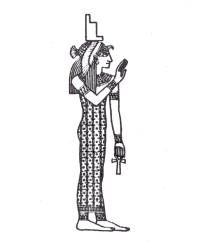 |
 |
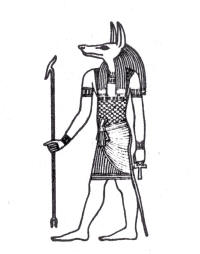 |
 |
|
ISIS, wife and sister of
Osiris was gifted with great magical powers. Among other good
works, she protected children -- which made her most popular of Egyptian
goddesses. |
RA, the sun god of
Heliopolis, became a state deity in the Fifth Dynasty. Some
traditions made him the creator of men, and the Egyptians called
themselves "the cattle of Ra". |
ANUBIS,
the jackal-god of mummification, assisted in the rites by which a dead
man was admitted to the underworld. He holds the divine scepter
carried by kings and gods. |
NEPHTHYS,
sister of Isis, was a goddess of women. Her name means "Lady of
the Castle", and she was associated with the home of Osiris, who she
helped restore to life. |
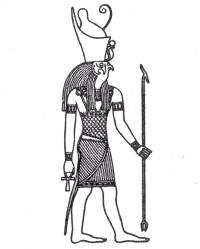 |
 |
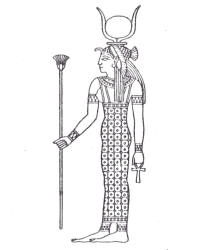 |
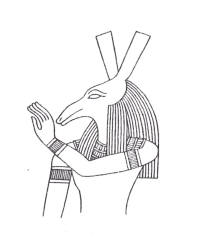 |
|
HORUS, the falcon-headed god,
holds in his right hand the ankh, symbol of life. The kings of
Egypt associated themselves with Horus, who was the son of Isis and
Osiris. |
OSIRIS,
a god of the earth and vegetation, symbolized in his death the yearly
drought and in his miraculous rebirth the periodic flooding of the Nile
and the growth of grain. |
HATHOR,
horned cow-goddess of love, was also deity of happiness, dance and
music. When a child was born, seven Hathors came to his bedside to
decide his future life. |
SETH was regarded as the Lord
of Upper Egypt and was represented by a big-eared imaginary animal
resembling a donkey. He was associated with the desert and storms. |
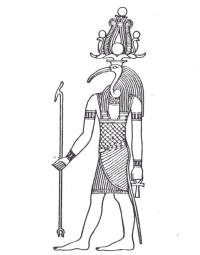 |
 |
 |
 |
|
THOTH,
depicted as an ibis or a baboon, was the god of wisdom and is associated
with the moon; as the sun vanished, Thoth tried to dispel the darkness
with his light. |
PTAH,
a local god of Memphis, was the patron of craftsmen. Some legends
say he spoke the names of all the things in the world and thereby caused
them to spring into existence. |
SOBEK, a crocodile-god, was
worshipped in cities that depended on water, such as the oasis city of
Crocodilipolis, where the reptiles were kept in pools and adorned with
jewels. |
AMMON, god of Thebes, was
usually shown as human, but sometimes as a ram or a goose. The
Romans later worshipped him as Jupiter. Ammon and consulted
oracles as his temple. |
Final Exam, Egyptian
History
Exam Time: 2-1/2 hours
Part I: (15 points)
Write short notes on five (5) of the following:
1.
Development of the pyramid structure
2.
Mummification of the bodies
3.
The Osirian legend
4.
Akenaton
5.
The ptolemies
6.
The Library of Alexandria
7.
Serapis
8.
St. Mark
Part II: (15 points)
Write short notes on five (5) of the following:
1.
640 A.D.
2.
Bonaparte's expedition to Egypt
3.
Mustapha Kamel
4.
Khedieve Ismail
5.
Pan Islam
6.
The Wafd Party
7.
al Azhar
8.
The Five Pillars of Islam
Part III: (10 points each)
Answer three of the following questions:
1. Discuss the importance of
industrialization for a developing country like Egypt and describe how this
might occur here.
2. The influence of the Coptic
Church extended beyond the boundaries of Egypt. Discuss with reference
to the contribution of the Coptic Church to the Church Universal.
3. Egypt's demographic and urban
problems may be viewed as functions of Egypt's distorted development.
Elaborate this contention in historical and contemporary perspectives.
4. Enumerate Mohammed Ali's
contribution to the regenesis of Modern Egypt in the Nineteenth Century.
What were his motivations and what was the external response.
5.
Major problems face the Egyptian people and their government if they are to
raise the standard of living. Outline the economic measures which must
be taken and the constraints within which these must operate.
|
